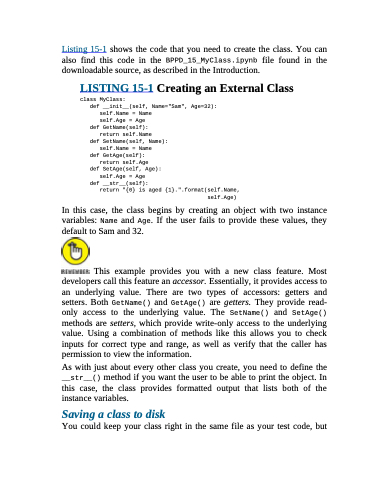Page 356 - Beginning Programming with Pyth - John Paul Mueller
P. 356
Listing 15-1 shows the code that you need to create the class. You can also find this code in the BPPD_15_MyClass.ipynb file found in the downloadable source, as described in the Introduction.
LISTING 15-1 Creating an External Class
class MyClass:
def __init__(self, Name="Sam", Age=32):
self.Name = Name
self.Age = Age def GetName(self):
return self.Name
def SetName(self, Name):
self.Name = Name def GetAge(self):
return self.Age
def SetAge(self, Age):
self.Age = Age def __str__(self):
return "{0} is aged {1}.".format(self.Name, self.Age)
In this case, the class begins by creating an object with two instance variables: Name and Age. If the user fails to provide these values, they default to Sam and 32.
This example provides you with a new class feature. Most developers call this feature an accessor. Essentially, it provides access to an underlying value. There are two types of accessors: getters and setters. Both GetName() and GetAge() are getters. They provide read- only access to the underlying value. The SetName() and SetAge() methods are setters, which provide write-only access to the underlying value. Using a combination of methods like this allows you to check inputs for correct type and range, as well as verify that the caller has permission to view the information.
As with just about every other class you create, you need to define the __str__() method if you want the user to be able to print the object. In this case, the class provides formatted output that lists both of the instance variables.
Saving a class to disk
You could keep your class right in the same file as your test code, but


